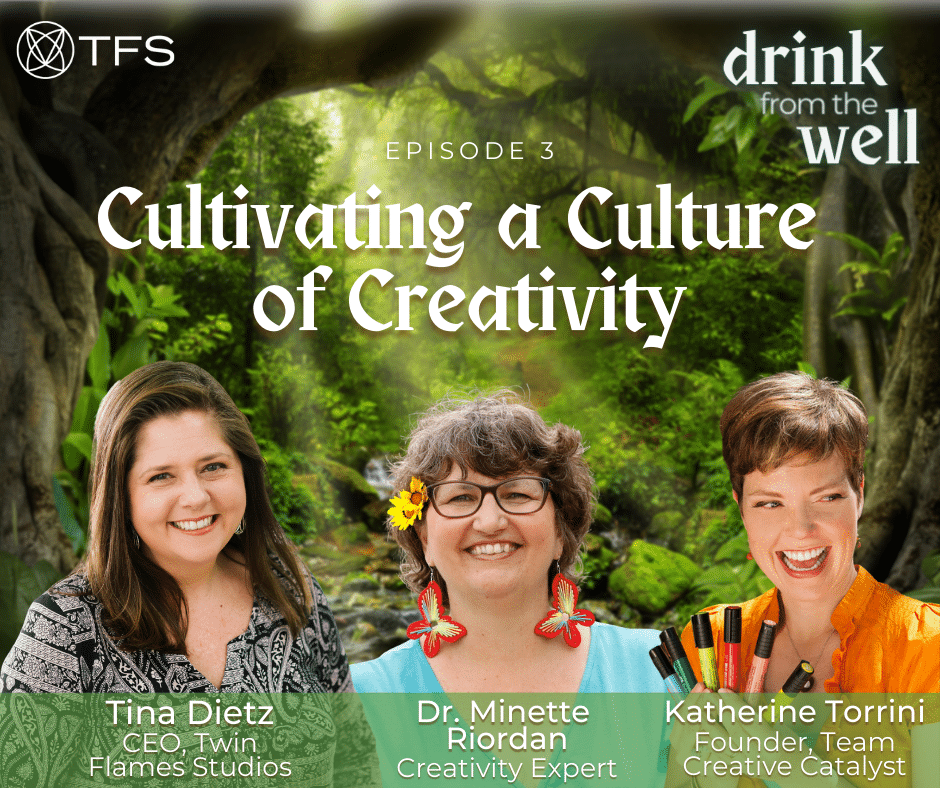
Drink From the Well Podcast, Leadership, Podcast, Productivity
Episode 3
Cultivating a Culture of Creativity
Why is Cultivating a Culture of Creativity in the workplace so important to success? Tina Dietz and creativity experts Dr. Minette Riordan and Katherine Torrini explore the benefits of letting your creative juices flow, how to encourage creativity among your employees, and how to overcome obstacles inhibiting your creativity.
Don't miss our Leaders' Discussion Guide for this episode below – perfect for your next team Lunch & Learn!
Cultivating a Culture of Creativity – Episode Highlights
- Distinguish between creativity and innovation in the workplace and how they’re related (4:38)
- Identify red flags that arise when creativity is not present in the workplace (7:58)
- Discover why people hesitate in exploring creativity despite its benefits (9:44)
- Find out how we can start to shift cultures in the workplace to allow for more creative thinking (13:07)
- Figure out ways leaders can model the value of creativity in the workplace (15:56)
- Learn about potential tiny creative acts you can do to get your creative juices flowing (27:26)
Full Transcript
Katherine Torrini
We value being right and knowing. And creativity is about not knowing and about not needing to be right. In fact, when I teach doodling to teams and executives, I actually pass out little stickers that say dare to suck.
Tina Dietz
There's a drop of inspiration, a dash of creativity, plenty of communication, and there you have it, our executive elixir. This is Drink From The Well. Welcome, lovely leaders, to Drink From The Well. I'm your sorceress of strategy, Tina Dietz. Companies often fail to thrive because they don't keep up with an ever-changing marketplace. Fostering a workplace culture where creativity thrives not only prevents stagnation and encourages innovation, but also unlocks high productivity and workplace satisfaction. Today's episode also includes powerful visuals, so make sure you visit DrinkFromTheWellPodcast.com so you can soak those in along with all the links to resources mentioned today.
And now to the data! A survey by IBM of more than 1500 chief executive officers showed a consensus. Creativity was ranked as the number one factor for future business success, above management, discipline, integrity, and even vision. One reason for this highest of rankings is that creative leaders are more comfortable with ambiguity. And I think one thing we can all agree on is that we're living in times where being comfortable with ambiguity is a huge advantage. As industries continue to evolve, business goals and priorities are changing with increased speed. 8 in 10 of those surveyed CEOs said they expect their industry to become significantly more complex, but fewer than half of those same 1500 CEOs are confident their organizations are equipped to deal with the transformation. Today on the show we're exploring the benefits and challenges of cultivating a culture of creativity in the workplace, along with sharing some wonderful ways of exploring and unlocking your own creativity on this wild adventure we call leadership.
I am very happy today to be sharing with you two of my wonderful colleagues who swim every day in the waters of creativity. And I've had the pleasure of working closely with both of our guests on different projects. Dr. Minette Riordan is an award-winning entrepreneur and creativity advocate. She is the creator of the Emerge method, a process of helping others map their purpose. Dr. Riordan is the author of three books, including her best seller, The Artful Marketer, with her mantra of “how hard could it be?” Dr. Minette believes when we're all working inside our creative genius, we can solve all the world's problems. I think I agree.
Katherine Torrini is a creativity expert, visual strategist and innovation catalyst who has brought her visual magic to the likes of NASA, Dell, Coca-Cola, Chevron, AT&T, and Southwest Airlines. She makes the invisible visible during meetings and events through graphic recording, drawing real time mural-sized infographics that mesmerize viewers, activate creative problem solving, and unlock the wisdom of the room. And I can say, personally, I have been subject to that visual magic. So welcome, today, to both of you to Drink From The Well.
Dr. Minette Riordan
Thanks for having us.
Katherine Torrini
My pleasure, wouldn't have missed it.
Tina Dietz
Today, we're talking about creativity. And of course, everyone can tell from your introductions why you're here today. The first topic that I wanted to bring to our table today is why is creativity even important in the workplace? I mentioned some things earlier in the episode with some data and with some assertions that creativity is important for several reasons. But I really need to hear from you. Katherine, let's start with you today. Why do you think creativity is even important in the workplace?
Katherine Torrini
Well, what I like to say is that creativity is the core, it’s part of who we are as humans, and it's part of our ability to invent our future. And the heart of innovation is creativity. They're not exactly the same thing and it's important to know the difference. But you can't get to innovation unless you're thinking creatively. And the reason you need a culture of creativity is because there's a few tips and tricks to make creativity actually work and flow that are a bit contrary to how we run our regular normal adult business lives.
Tina Dietz
And Minette, how would you like to bounce off of what Katherine is saying?
Dr. Minette Riordan
So I love what Katherine said. And I would add to that that creativity is vital right now in our rapidly, radically changing environment of technology. The thing that always sets humans apart is our creativity and our innate ability to problem solve, but also because creativity makes life more fun. And I think inside the workplace what's missing are some of the elements of play and fun that give people permission to fully be themselves and express their creative ideas.
Tina Dietz
Yeah, let's dig down a little further into the idea of innovation and creativity. Katherine, you said that it's important to know the difference between the two even though they're tied together. Can you tell us more about that?
Katherine Torrini
Absolutely. I was just looking outside this morning at my beautiful oak tree in the backyard, which has recently dumped all its leaves and all its pollen, tons of bags and bags. Only one or two of the acorns that come from all that will become trees. And I would say that innovation is like that acorn. It is the creativity that ends up being useful and implementable, if you will. Creativity is the leaves and the pollen and the acorns. So you can't get to those few really innovative ideas if you don't have a place where you have lots and lots of creativity. So the innovation, I would say, is applied creativity. I'd love to hear Minette’s take on that as well.
Dr. Minette Riordan
No, I completely agree with that definition. And I love the analogy of the oak tree. But please don't mention pollen. I'm in the middle of pine trees that are about to burst into pollen right now. But no, I love that analogy. I think there's a lot of creativity that is imaginative, playful, and fun. It's not all useful. Yet, we have to be in that culture of getting used to just sharing the ideas, whether they're going to go anywhere or not. And then innovation is the piece for me that helps us decide, is it implementable? And can there be an action plan built around it? But we put way too much emphasis on innovation first and not enough on creativity, which I think is a different way of saying maybe what Katherine was saying that we have to just really nurture the culture of ideation first, because the more ideas, the more radical solutions we can create.
Katherine Torrini
Absolutely. And I want to just underline something that you said that the fun and the joy might not be, quote unquote, useful. So it's not useful, necessarily, in a product, but it's very useful –
Dr. Minette Riordan
Right.
Katherine Torrini
In the culture, in the people, in the person's experience, and I know you know that, I just wanted to underline that for listeners.
Dr. Minette Riordan
Yeah, no. I think it’s super important that you brought that up.
Tina Dietz
Yeah, there's often this sense of what has to happen in a company is you have to hit the bullseye on the first try. And good ideas just don't work that way. So let's create a little contrast. If you're in a company, and it's clear that it's not a culture of creativity, what are the pitfalls? What are red flags when creativity isn't present?
Dr. Minette Riordan
I love this topic. So I think what happens is people stop valuing their own creativity. They hold on to their ideas, they're afraid to voice them out loud for fear of judgment, or it creates this incredible amount of stress that they have to get the bullseye the first time out of the gate. And I think we talked a little bit in our pre-conversation about this idea of having interdepartmental conversations. And so I think because a lot of times creativity gets buried in the creative department that we're losing out on the creative thinking abilities of people across departments in a particular company. So, for me, the pitfall is we're missing out on the genius of all the people in the company that could be contributing to that ultimate bottom line that the stakeholders and shareholders care about.
Tina Dietz
The research that we did prior to this episode is pretty conclusive that improving innovation, ideation, creating fun culture, as you said, which results in more productivity, which results in more retention. And we all know that talent retention and talent development in companies is a huge issue right now. We found correlations with confidence and that innovation, of course, which is tied to creativity, is certainly tied to the bottom line and tied to profit. So why would we even hesitate in the workplace to explore creativity? You both touched on a few things where people have those kinds of self limiting beliefs, but in a workplace culture, why do you think that people hesitate in exploring creativity?
Katherine Torrini
We value being right and knowing. And creativity is about not knowing and about not needing to be right. In fact, when I teach doodling to teams and executives, I actually pass out little stickers that say dare to suck. I spend as much time debunking that they can't draw, they can't doodle, as I do teaching them to doodle because that's the biggest roadblock, I would say.
Dr. Minette Riordan
And I would say what's underneath our need to be right is fear. Fear of judgment is one part of it, fear of looking silly or less than in front of our teammates. But I have also heard from a lot of women doing research on women in leadership, fear of having ideas stolen is one that I have heard come up in the research over and over again. And I've had colleagues share examples of that happening, so they hold on really tightly to their ideas.
Katherine Torrini
Absolutely.
Tina Dietz
I've heard that from many, many leaders over the past both as a coach and in podcasting, in vocal leadership, that there is that issue, and I've certainly experienced it myself, of translation. What you see in your head is so full and rich, and then being able to actually communicate that when you may not have the artistic skill to draw it or be able to do it in some sort of digital format but then it does come back down to writing and visual and communications. And if we don't have to hit it on the first time, if we don't have to be perfect the first time out and we allow space for that creative, iterative process, multiple iterations are required to kind of get down to when we get to that product point or even to a decision making point. It's so important to allow the room for that.
I was recently listening to the audiobook version of a little book I didn't even know existed that John Cleese from Monty Python wrote, called Creativity: A Short and Cheerful Guide. And he cited some interesting research from the 60s on creativity. There was tons of research done in the 60s and 70s on creativity and then it got shelved for a very long time. But they did some research out of Berkeley on, I believe it was, architects and what constituted a creative architect or non-creative architect. One of the biggest factors in these architects who were considered in their industry highly creative was that they delayed having to make a decision for as long as they could. Not that they were procrastinating, but there had been a determination of, “Okay, we need to make a decision on this particular whatever it was in the project at this time.” And they didn't make a decision before that; they waited the entire time and then made a decision when they had to. So they had the maximum amount of time for that idle thinking, for creative iteration, for the processing time, for new information to present itself. And that generally ended up with a better quality idea at the end of the day or a better quality product. And I just find that really fascinating that we live in this culture where we often have a better product if we allow the time to wait. But there's such a time push for doing that. So do you have any thoughts on how we can start to shift cultures in the workplace to allow for a little bit more creative thinking or that idle thinking time?
Katherine Torrini
A couple of thoughts. One is scheduling spontaneity, if you will, not because you're like, “Okay, now we're here at nine o'clock, and we have to be spontaneous.” Because you're actually creating, putting aside time, you're putting it on your calendar, you're making it a priority. And as important as the other things. And the other thought is this: We often treat creativity in a transactional way, like, “I'm going to be creative, I'm going to sit down, I'm going to do this thing.” And I like to think of it more as a relationship. I joke that if you had a relationship with your sweetie, or with a best friend, and all you ever did was clean the garage, or go out to a fancy dinner, you're always on it, producing, you wouldn't have a very great relationship. So for me, a culture of creativity is a culture where you have a relationship with your creativity that sometimes turns into fabulous innovative ideas, and sometimes turns into a great product idea or a great way to implement service. But it isn't only transactional.
Dr. Minette Riordan
And I think we have to give people permission in the workplace to have creative ideation time, right? To be in that idle thinking, daydreaming, feet up on the desk, go for a 20-minute walk when you're feeling stuck. And so I think there has to be a culture that allows for that time, because people get so guilty. I even hear retired people say, when I'm not doing something, I'm not being productive, and if I'm not productive, I don't have value. And so idle time is often seen as a lack of productivity when it's the opposite. And our best ideas come, actually, from deep rest and deep play, not from work. And so making sure that we're scheduling that time, and then I 100% agree with scheduling spontaneity or scheduling creative work time, because what happens is our brains start processing before we ever sit down. And I think it was, I can't remember, it might have been Hemingway, but there was one writer who said at the end of every one of his writing sessions, he always left a sentence unfinished because he could come back the next time and just to pick up the pen and continue the story from that place. But if we come to a stopping place at the end of the sentence, then it feels done. And instead, that open-ended opportunity for creative thinking continues way outside the page. So I think learning, and I love how you described it, Katherine, as a relationship with our creativity feels right on and understanding that when we're washing dishes and taking showers, this is all creative time.
Tina Dietz
Well, then, let's take a look at how can leaders – because leaders, we're the ones that are really modeling for our team, we're the ones who can really help embody the value of creativity to our own creativity in the workplace as we're leading – how can we start to ease into that more as leaders? What are some things we can do to model or embody to cultivate creativity in the workplace by our own example?
Dr. Minette Riordan
Taking time off, which leaders tend, including me, have a hard time doing, but actually scheduling an afternoon out of the office for creative time. A company that my husband and I have done a lot of work with over the last few years, Ontraport, I love the CFO says she has to kick the CEO out. She's like, “You get your best ideas when you're away from the office. Wednesday, I'm canceling everything on the books. Go away.” And so I think encouraging a culture of spaciousness instead of the over emphasis on productivity. What I hear from most people in corporate is their jobs are just so dense and there's so much to do, that the thought of taking an afternoon off is just completely daunting, and not necessarily supported by leadership.
Tina Dietz
Yeah, whoever heard of somebody saying I got the best set of ideas at my desk today?
Dr. Minette Riordan
Not me.
Tina Dietz
Yeah, it's always in your shower. It's in your car. You're at the park, over coffee, it's in a conversation. That's that kind of back end mental thinking where things are running on a subconscious level or semi-conscious level and then all of a sudden, bam, there it is, or you go to sleep at night, and you've been wrestling with a problem and in the morning, you look at it with fresh eyes and all of a sudden, it's as though your brain has been working on it all night, which it has. And then there it is in front of you, you can continue on. Katherine, what are some other ways that you see that we can model or embody this cultivating our own creativity at the workplace so that our teams can benefit?
Katherine Torrini
I completely agree with what Minette said about taking time off. It's not taking time off, you're actually on. I have something that I call a creative off site, or, it's a studio week is what I call it. I realized later when I was reading a book about productivity, actually, that it's a sprint, it's a creative sprint. So I actually was a little scared the first time or a little nervous the first time I said I'm out of the office in the studio this week working on internal. I'm working on this project. So I marked off and kind of publicized, I guess, because I put in my out of office, that I was focusing. I wasn't off having a vacation, which is also very important. I was focusing on a creative project, and I gave myself a whole week to build up to it, get ideas, and then four and five, you're in the, like, “Okay, we're doing the thing, I'm creating the actual final pieces.” And that's a fantastic way. I want to also talk about something that I call Friday My Day, which I know not everyone can do. But if you manage your own schedule, I've actually realized that if I didn't have a day for me as a creative and as a content producer to do whatever I wanted to happen – oftentimes it's classic, I'll take Friday off, and then I'll go for a hike and I'll just be writing blog posts on my phone, I'll be dictating, I get super creatively activated. And so I just started making it official and calling it Friday My Day. Either I'm creative and create content or I rest so that Saturday or Sunday or Monday I'm creative. I hate having to choose between creating content, like maybe I'm writing a course or a blog post or whatever it is, and hanging out with my family and taking care of my own self. You actually need to take your personal self care for who you are as a creative, and you need creative time. And that's how I've kind of built it into the week.
Tina Dietz
Yeah, Katherine, I've heard you say before, “Creativity shouldn't just be for dessert. It's part of a balanced diet.” I love that.
Katherine Torrini
Did I say that? That’s an awesome quote.
Tina Dietz
You said that.
Dr. Minette Riordan
That is an awesome quote.
Tina Dietz
Minette, you have some really good tips on being with our teams and some ways to bring our creativity as leaders, things we can do to model with our team, specifically, not just out of the office. Tell us some of those.
Dr. Minette Riordan
Yeah, so, as I was listening to you and Katherine, one of the things that came up in my mind was sharing your hobbies. I think we often also don't necessarily talk about what we do outside of the work, but maybe take everybody to a paint and sip once in a while to get out. And because no one necessarily does a great job there, then everybody gets to be in that beginner's mind together. But in sort of the management of being with teams, the most important thing is to create a culture of safety and openness around honoring the ideas. And one of my favorite approaches to that is to play the what-if game, and in fact, when anyone shares an idea, if you just put those two words, what if we, or what if you, or what if I in front of it, that takes all the should energy or must energy out of it, which triggers all of our inner rebel anyway. So playing the what-if game with everybody, and there's no feedback given on the ideas, there's only input of ideas, whether you bring in someone like Katherine to capture all that, which is genius, or whether people are writing on sticky notes or whiteboards and sticking them on the wall. I also always recommend, as much as possible, making that process visual. So I love the idea of bringing in someone like Katherine to help that because not everyone is an articulate thinker, from thought to word. And in fact, our very first language was through imagery. We started to recognize visual signs, our mother's faces, and through smell, and as Katherine said, then through drawing before we ever got to writing. So words aren't our first language, images are. So the more visual we can make these processes, the sillier it becomes. So think Pictionary for teams. And again, it's taking that pressure out of it needing to be a rigorous scientific process to get the best possible idea. So play. It all comes back to that idea of just deep play.
Tina Dietz
Game Night. It’s kind of like it's not just for families, we should have it in our teams as well to free that up and be able to enjoy each other in the workplace, not just work together. One of the things I've always valued even though I've always run a remote team from all over the place is we will, as many of us have a background in voice acting, being an audio-based company, and a lot of times in team meetings we'll end up having an entire or part of a team meeting doing different character voices. And it's absolutely ridiculous. And it happens fairly organically, or we’ll end up in a pun war talking about something in a team meeting. I'm always grateful to my team for being willing to play and kind of jump into that space. And the interesting thing is, almost inevitably, when that happens, at the end of the conversation, someone will pop up with something, it's like, “Hey, I just realized something,” or, “Hey, I just thought of this.” And that little bit of play will stir something creatively in the team that moves the needle on something, what would have been completely unrelated. And in the research we did, we saw this reflected over and over again, that this space needs to happen. So we're all born creative. We're all born with imagination. And as we get older, that can get shut down a little bit. So when you are working with people, with teams, with leaders, how do you help people reconnect to their creativity? Katherine, let's start with you.
Katherine Torrini
Well, one of the key things to do is to first name the fear. You have to actually be in what we call right relationship with your inner critic, because we all have them. And that's the elephant in the room, if you will, or the saber toothed tiger in the room, if you will. I'd like to say that our inner critics are there to keep us safe and they're bored because we don't really have physical safety issues now, generally speaking, as adults in the working world. Sometimes I'll have folks do, to reduce the pressure and increase that feeling of psychological safety, we’ll actually do a saber toothed tiger check. We'll ask them to have fun with it and look around the room. Are there any saber toothed tigers? No, are you sure? Okay, if there are, by all means run, but if there aren't, then we can relax into this moment and play a little bit. So naming and demystifying the inner critic and showing that everyone has one and that it's going to come up during creative processes and it's part of the process, and you can just move past it pretty quickly, rather than stay stuck there, that's, I think, one of the key things. That's one of the things that when we talk about cultures of creativity, everyone's like, “Okay, great.” And then these things come up. And so we have to be prepared to deal with them.
Dr. Minette Riordan
Yeah, I love that. So I would take it even one step further and ask them to personify their inner critic, and have them draw a picture of what their inner critic looks like. And I remember leaving a workshop and this one woman, her inner critic was this little Sapoa Frog. And she's Hispanic. And I can't remember the frog's name, but it had a Hispanic sounding name. And it was just freaking hilarious, right? But when we can personify, again, it's that visual representation, we can have a conversation with it, we can create a different dialogue, we can take it and turn it upside down on the desk, or send it out for a cup of tea or a glass of wine. So I think personification would be the next thing. But I also love to get them to see all the ways they are already being creative that they hadn't thought of. So to make a list of the things that they enjoy doing: cooking, gardening, dancing, all the ways they’re already in that sort of atmosphere of creative problem solving and imaginative thinking outside of the workspace.
Tina Dietz
One of the exercises that you do with your clients and also online, Katherine, I've seen you do, is this lovely idea of tiny creative acts, just little tiny things that you can do in short periods of time to help us get those creative juices flowing. So I would love to, right now, have a little playtime with the two of you and just do a little live brainstorm of potential tiny creative acts. And then we'll make sure all these little ideas are there for our listeners in the show notes on our website. And also, we'll have some visuals of some of both of your work so we can get a feel. I mentioned in the top of the episode, we have some powerful visuals in our episode today. So it's going to be extra important that listeners go back to the website so they can get these tiny creative acts, get inspired, and also get inspired by some of the visuals that are going to be there from the two of you. So are you ready to do a little bit of brainstorming together?
Katherine Torrini
Oh, yeah.
Tina Dietz
Okay, so brainstorming rules apply, which are basically, the wilder, the better. If you repeat somebody's answer more than once or you piggyback on it, that's wonderful. Iteration is great. There are no wrong answers. And we're just going to take a very quick 90 seconds to do this, so that it is a little bit more compressed for time so we have that energy in there. All right, ready and go.
Katherine Torrini
Double doodle.
Tina Dietz
You can explain it.
Katherine Torrini
There's the doodle game where you just do a scribble and then you turn it into a bird by adding a beak and feet.
Dr. Minette Riordan
So soul scribbles where you just draw on a page and then you imagine what you can see in that. So now it takes 30 seconds and it's super fun.
Katherine Torrini
Take a line for a walk, where you imagine that the page that you're looking at is like a Google map of a neighborhood. And you take the line for a walk around the neighborhood as if it were a dog.
Dr. Minette Riordan
I love that one. Mindful color play, like draw a picture of colors having a party on a page, or your socks going to a party, like just anything where you're putting color on the page.
Tina Dietz
I know. One of my favorites is to grab some of my kids stuffed animals and give them my internal voices, external voices with their stuffed animals and have them talk to each other or even do it with other people just to create a little story.
Dr. Minette Riordan
Oh, I want to do that one.
Katherine Torrini
I love it. And to piggyback on that, I have people make paper bag puppets of their inner critic, and then have them talk in that funny voice that they have, whatever it is, and then you can crumple it up and throw it across the room or stick it in a drawer.
Tina Dietz
Kick it.
Katherine Torrini
Throw it in the trunk.
Dr. Minette Riordan
Yep, I love that. Index card art, like really practicing creative constraints and limiting the size. So little scribbles and doodles on index cards. But I saw some things on Katherine's website that I really loved that I also do, and it's to take the practice outside. So one of my favorite creative practices, it's a creative act, is making mandalas in nature. So just especially on the beach, gathering seaweed, rocks, sticks, anything like that, and creating a mandala out in nature is really fun for me.
Katherine Torrini
What I love – I'm going to build on that. The beauty of a mandala is that when you make one decision, you just repeat it all the way around. So it ends up looking really cool, but you don't have to know where you're going. And one little decision makes all the decisions for you. So another creative act is whenever I find fallen flower petals or leaves, or I’ve even done this with dirt, you just play with it and turn it into something. I often will do hearts or something else or a smile, and then you photograph it and leave it wherever it is. Like the idea that it's ephemeral and it'll be washed away, or maybe someone will come and eat it. Maybe some animal will come and eat it if you put berries in a particular line to really get away from the idea of product and just be in that joyful, playful, childlike relationship with your creativity.
Dr. Minette Riordan
Yeah, building on that, sidewalk chalk is your best friend. Grab your kids’ sidewalk chalk and go out and leave love notes on your front sidewalk for your neighbors. Draw hearts or silly pictures. So sidewalk chalk outside is super fun.
Tina Dietz
Quick ones also are dance breaks. Just a little bit of music and dancing around or maybe even allowing yourself to feel like you're embodying an animal or a character or a rockstar of some kind. Take two minutes and just allow yourself to pretend, maybe like you did when you were a little kid, that you were either a superhero or a rock star or something like that and dance to the music.
Dr. Minette Riordan
One of the most fun things I saw during the pandemic was when a neighbor put a big chalkboard out in front of his house and every day he had a new dad joke on the chalkboard. I would walk out of my way around my neighborhood to see dad jokes. So what if in the workplace there was some place where people just got to tell silly jokes where we walk by and it's written on a whiteboard somewhere. So dad jokes are awesome.
Tina Dietz
Just like his own church sign. That's amazing.
Dr. Minette Riordan
It totally was. It was brilliant.
Tina Dietz
I love that. I love that. I love that so much. All right, great. So I think this is only scratching the surface of what's possible with tiny creative acts. We will put all of these together in a list. And if you are following us on social media, we're also going to be posting about these tiny creative acts and inviting you to add on your own tiny creative acts, things to do. Creativity thrives in community, and it thrives in communication. And I think it's so interesting that both of you touched on some other themes from some of our other episodes. Psychological safety was one, that was one of our first two episodes, psychological safety and on sharing your hobbies and bringing your whole self to work and how hobbies actually can transform and influence leadership. So it's always so interesting to me how, as we're exploring these different aspects of leadership and workplace culture and communication, how everything connects the dots together. And I appreciate both of you being here today. Let's finish up with just some creativity resources that you might recommend. We’ll certainly recommend both of your websites and social media links, which we’ll, of course, be including, but what about books, workshops or conferences that you might recommend? Minette?
Dr. Minette Riordan
Well, that's a big one. I'm super excited to be speaking this year for the first time at the CPSI, the Creative Problem Solving Institute Conference, which, to be steeped for a week, not even excited about my presentation, but about being around all these people in the creative problem solving industry. So CPSI is a great one for people to consider. Florida also has a big creativity conference annually that's a very, sort of, almost an unconference open format model. I haven't been to that one, but I've heard it's super imaginative and playful. So those are two conferences off the top of my head. And my list of books is way too long to even get started, probably like Katherine's.
Katherine Torrini
Where I would point folks is, this is the work for the leader or for individuals and the leader, although she does have The Artist’s Way at Work. The Artist’s Way was foundational to my recovering and discovering my creative self as an adult, and I've always identified as an artist, so it's great. It's powerful work. I've done it many times, I've taught it, and I highly recommend it. And in fact, my creativity courses are inspired by some of the structures that she has in her course.
Tina Dietz
And that's Julia Cameron right?
Katherine Torrini
Julia Cameron, yeah.
Tina Dietz
Julia Cameron, right. Well, we will include some of these, as well as some additional links to other books, associations, conferences and articles on our website at DrinkFromTheWellPodcast.com. Thank you so much for being here today, Dr. Minette and Katherine for this conversation on creativity. And thank you for being out in the world with your full heart and for being these expert, vulnerable leaders who create such lovely spaces for people to step into to create more creativity and results in the workplace as well as in their own lives. Thanks for gathering around the well with us today. And I invite you back for another drink of our executive elixir as we bring the worlds of leadership, innovation, creativity and communication together. Follow us on your favorite podcast app and journey over to DrinkFromTheWellPodcast.com for transcripts, show notes, and links for all the wisdom in today's episode. We're always here to refresh and to entertain you anytime you need a drink from the well. Drink From The Well is an original production of Twin Flames Studios and hosted by me, Tina Dietz. This episode of Drink From the Well was produced by Stephen George, Rye Taylor, and our beloved tripod, which includes Nadia Cox, Alayna Carley, and Darek Blackburn.
About our Guest Experts – Cultivating a Culture of Creativity
Dr. Minette Riordan is a risk-taker and curiosity seeker who loves jumping feet first into business building and art making. Her mantra is, “how hard can it be?” A modern day Renaissance woman, Minette is an artist, writer, award-winning entrepreneur and advocate for creativity as essential to the well-being of all people and our planet.
She has built several successful businesses and published 3 books including her best seller The Artful Marketer. Minette is the creator of the Emerge Method™, a simple and effective transformational process for helping others to activate their creativity and map their purpose. She believes that when we are all working in our highest and best creative genius, we can solve all the world’s problems.
Katherine Torrini is a creativity expert, visual strategist and innovation catalyst who has brought her visual magic to the likes of NASA, Dell, Coca-Cola, KPMG, Southwest Airlines and The Institute for the Future.
A life-long artist and visual journaler, Katherine has found the perfect professional niche where her superpower of “thinking outside her brain” is highly prized and sought after: Graphic Recording and Visual Facilitation. She travels the world drawing real-time, mural-sized, infographics at conferences, talks and corporate events, where these spontaneous visuals mesmerize viewers, activate creative problem solving and unlock the wisdom of the room.
Katherine’s ability to make the invisible visible captures themes, illuminates connections and reveals patterns, while getting stakeholders “on the same page”—literally! This leads to increased engagement, deeper conversations, more innovative solutions, accelerated decision making and authentic buy-in. Always keen to share her markers, Katherine’s visual thinking trainings empower teams to use their whole brains to think, communicate and collaborate better.
Episode Featured Resources
The Artful Marketer by Dr. Minette Riordan
Creativity: A Short and Cheerful Guide by John Cleese
The Artist’s Way by Julia Cameron
Free Course: Paint Your Way to Self-Confidence
What is Graphic Recording?
Graphic recording is essentially visual note-taking. It involves the capturing and translation of spoken word into powerful, memorable drawings. Here are some stunning samples courtesy of Katherine Torrini:
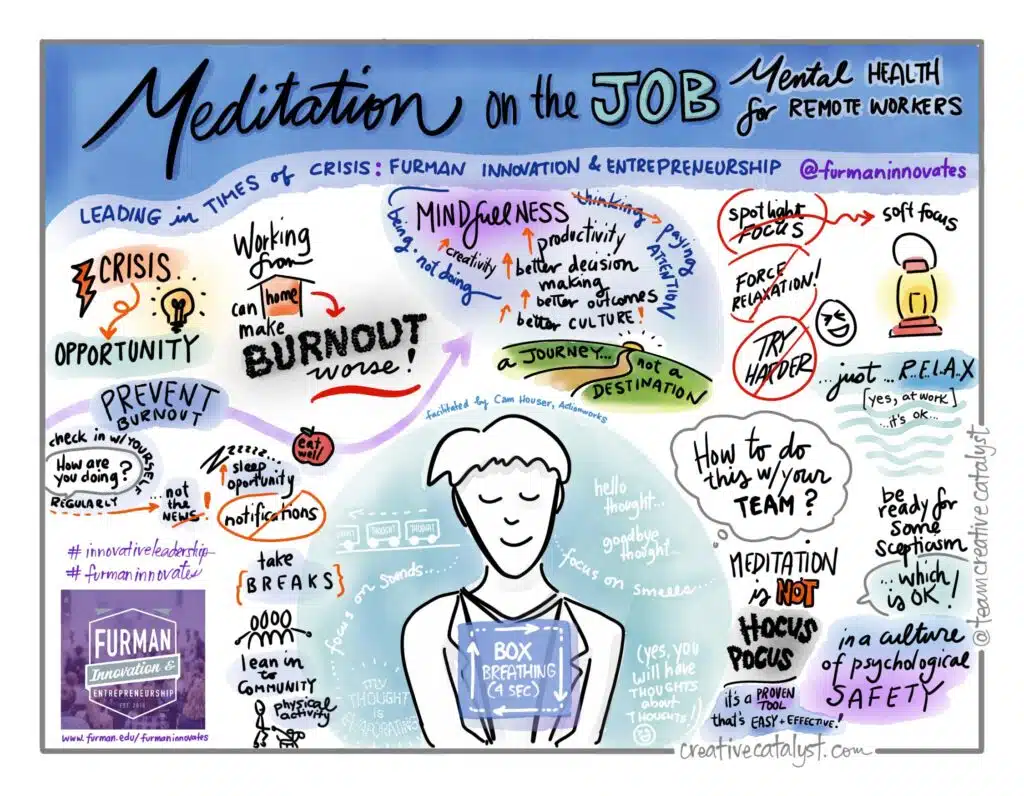
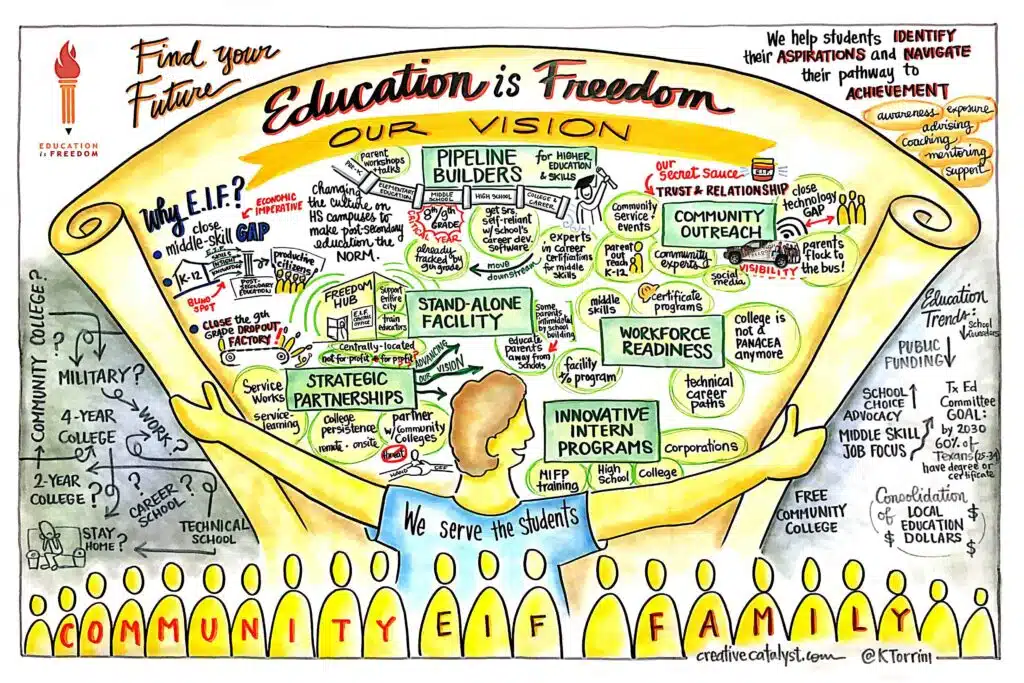
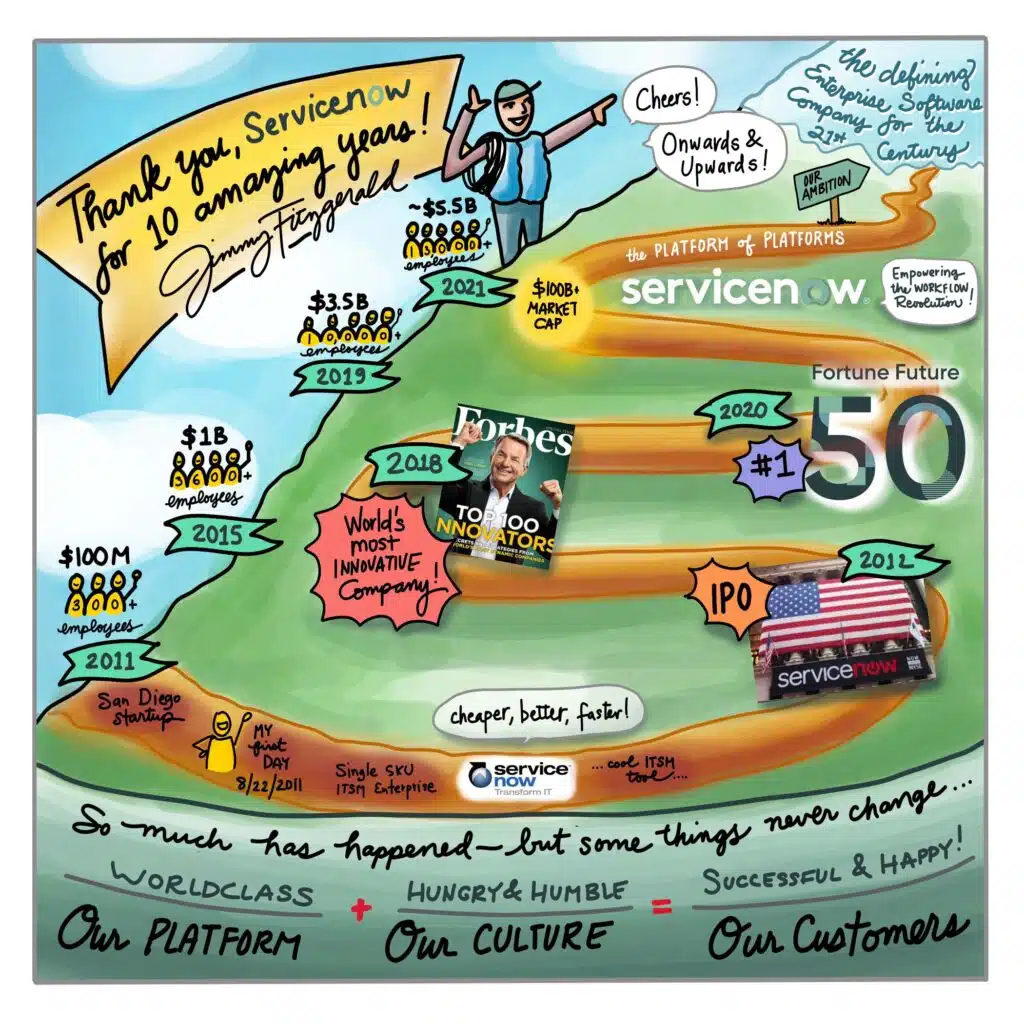
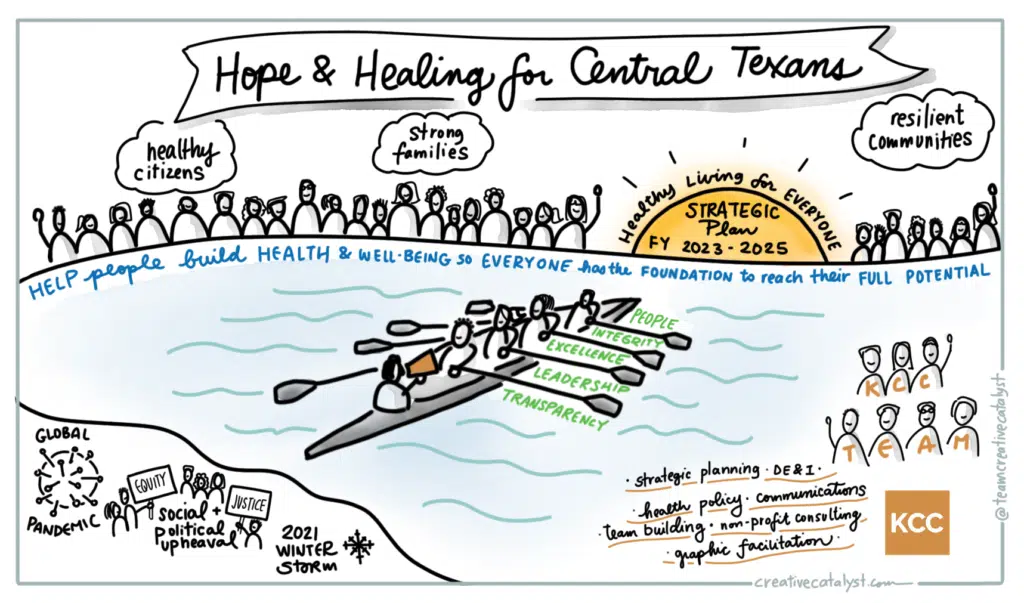
Tiny Creative Acts
Tiny Creative Acts are simple things that you can do in short periods of time to help get your creative juices flowing and futher help in cultivating a culture of creativity in your organization. Below are some examples. See the Leaders’ Discussion Guide for more examples and information.
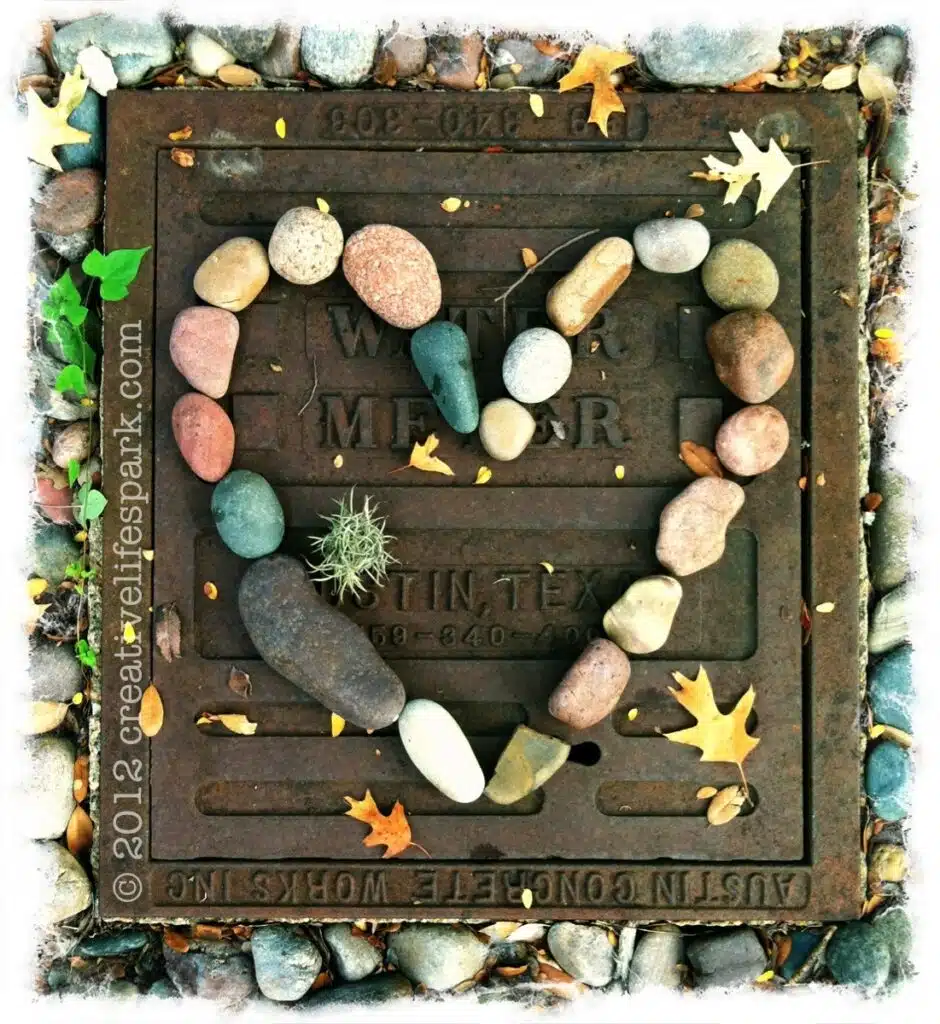
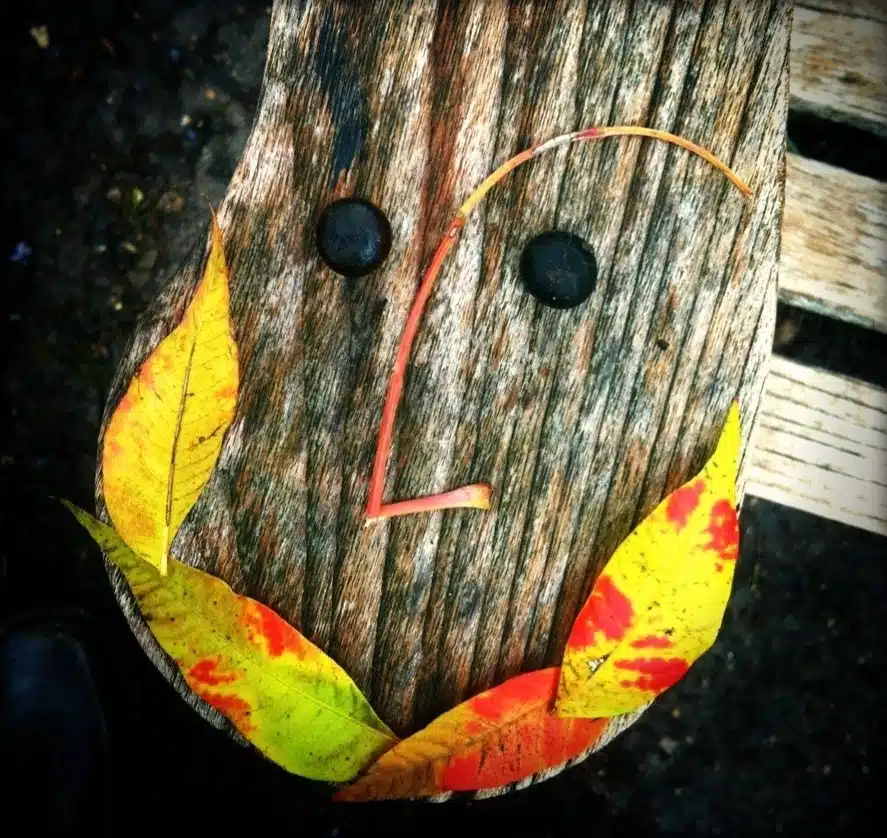
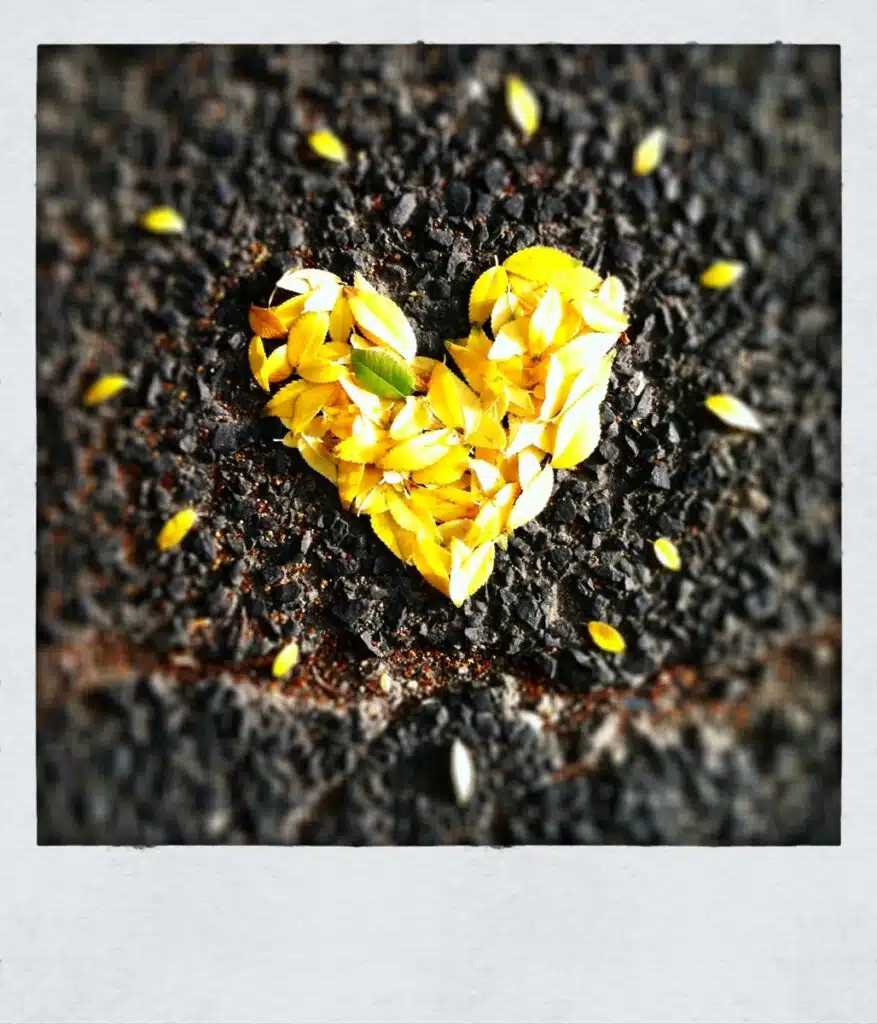
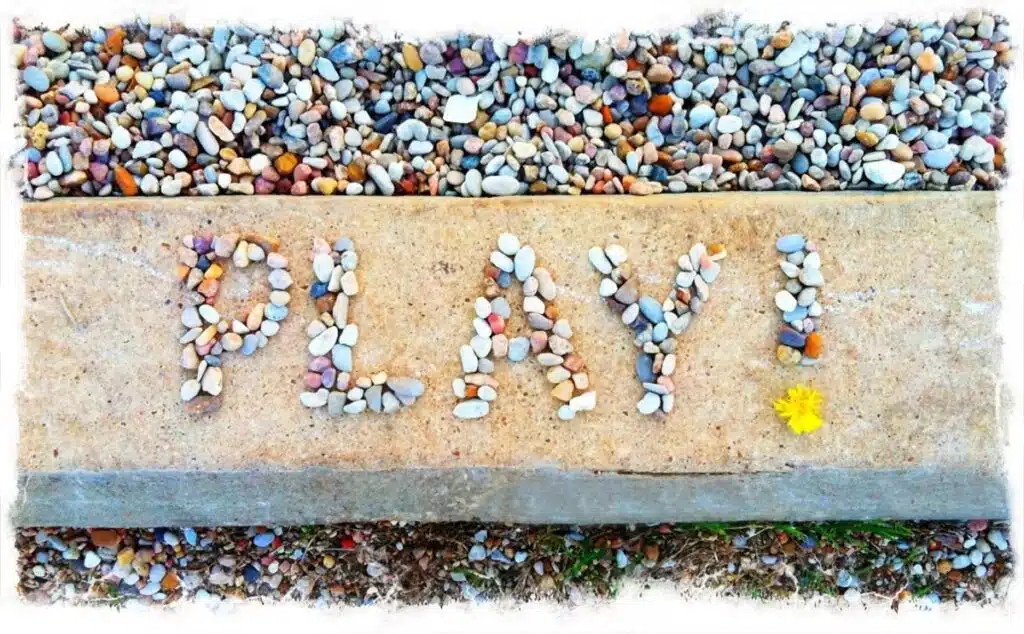
Leaders’ Discussion Guide – Cultivating a Culture of Creativity:
How to prepare to lead this discussion session with your team:
- Review the summary of the survey by IBM Tina discusses at the beginning of the episode by using the transcript above. Give yourself the space to answer these questions honestly:
- Whether you are confident in your organization’s ability to deal with ambiguity and transformation.
- What are the roadblocks your company is facing?
- Are you embodying and modeling the value of creativity in the workplace? Do you schedule creative time for yourself as a leader? Or is there an over-emphasis on productivity?
Questions to discuss WITH your team about Cultivating a Culture of Creativity in the workplace:
- Have them listen to the episode first to create common ground and context for the conversation.
- What ways are we currently fostering creativity in the workplace, or are we at all? Is there time in the day for people to have creative ideation time?
- Does everyone feel psychologically safe enough to share their creative ideas?
- Sometimes, we just need a little push. As a team, try one (or multiple) of these tiny creative acts mentioned in the show to get your creative juices flowing before diving into the decision-making and brainstorming for the day.
- Double Doodle: Doodle game where you just do a scribble and then you turn it into a bird by adding a beak and feet.
- Take a line for a walk: Imagine that the page that you're looking at is like a Google map of a neighborhood, and you take the line for a walk around the neighborhood as if it were a dog.
- Mindful color play: Draw a picture of colors having a party on a page, or your socks going to a party. Anything where you're putting color on the page.
- Give inanimate objects voices: Grab some stuffed animals and give them voices and have them talk to each other, or even do it with other people just to create a little story. Be as silly as you want.
- Index card art: Little scribbles and doodles on index cards to limit the size and practice creative restraints.
- Make mandalas: Gather seaweed, rocks, sticks, anything like that, and create a mandala out in nature.
- Sidewalk chalk: Grab your kids’ sidewalk chalk and go out and leave love notes on your front sidewalk for your neighbors. Draw hearts or silly pictures.
- Dance breaks: Just need a little bit of music and dancing around. Maybe even allowing yourself to feel like you're embodying an animal or a character or a rockstar of some kind. Take two minutes and just allow yourself to pretend, maybe like you did when you were a little kid, that you were either a superhero or a rock star and dance to the music.
- Company chalk/white board for people to write/draw on at any time: Some place where people just get to tell silly jokes where coworkers walk by and it's written on a whiteboard somewhere.
- ADVANCED: Take Dr. Minette Riordan’s advice (20:54) and prepare your team to play the What-If Game as it relates to your business.







Leave a Reply